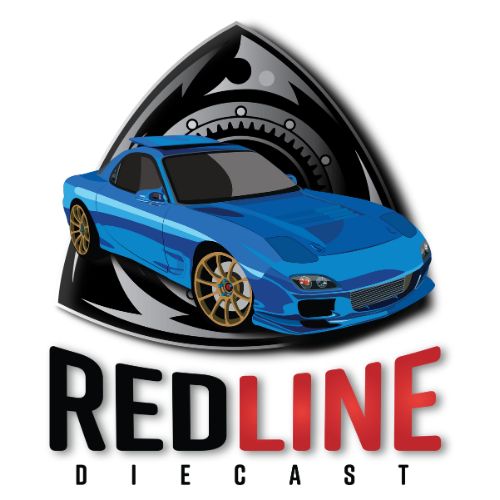The Complete Journey of a Diecast Car: From Concept to Collector’s Shelf
Diecast cars have captivated collectors and automotive enthusiasts for decades. These miniature replicas are more than just toys—they are intricately designed, finely detailed, and precision-engineered pieces of automotive artistry. But have you ever wondered how a diecast car comes to life? At Redline Diecast, we take pride in delivering high-quality, collectible diecast models, ensuring each piece meets the highest standards of craftsmanship.
In this comprehensive guide, we’ll take you through the entire diecast car production process, from the initial concept to the moment it arrives on your display shelf.
1. Design & Concept: Bringing Ideas to Life
Every diecast model begins with a vision. The first step in creating a miniature car is selecting the right vehicle to replicate. This process involves in-depth research, ensuring the chosen model resonates with collectors and automotive fans alike.
Research and Inspiration
Diecast manufacturers analyze market trends, collector demand, and historical significance before selecting a model. Whether it’s a classic muscle car, a sleek supercar, or a rugged off-road truck, the goal is to recreate an automotive icon in precise detail.
Sketching & Blueprint Development
Once the vehicle is chosen, designers create initial sketches to capture the car’s shape, proportions, and unique features. Digital renderings and technical blueprints are then developed to guide the production team in creating an accurate diecast replica.
2. Prototyping: Transforming Concepts into 3D Models
After finalizing the design, the next step is to create a prototype. This is a crucial phase where attention to detail ensures the finished model is as accurate as possible.
3D Modeling & CAD Design
Computer-Aided Design (CAD) software is used to construct a 3D model of the vehicle. Engineers meticulously refine the design, ensuring it captures every curve, line, and proportion of the real car.
Master Prototyping
A physical prototype is then produced using 3D printing or CNC machining. This prototype serves as the master model, which undergoes multiple adjustments and refinements before moving into full-scale production.
3. Production: Crafting the Diecast Body
Once the prototype is perfected, the manufacturing phase begins. Diecast cars are typically made from a metal alloy, often zinc, which provides durability and a premium feel.
Diecasting Process
The term “diecast” refers to the casting process where molten metal is injected into precision-engineered molds under high pressure. These molds, often made from steel, shape the body of the model car.
Chassis & Component Fabrication
In addition to the main body, other components such as the chassis, wheels, and interiors are produced. Plastic, rubber, and other materials are used to replicate realistic details, ensuring each piece fits seamlessly into the final product.
4. Painting & Detailing: Adding the Finishing Touches
The painting and detailing phase is where the magic happens, transforming a raw diecast shell into a stunning collector’s item.
Precision Painting Techniques
High-quality automotive-grade paints are applied in multiple layers to achieve a showroom-quality finish. Special techniques like airbrushing and electrostatic painting enhance the depth and realism of the colors.
Decal Application & Tampon Printing
Logos, stripes, and intricate details are added using water decals or tampo printing. This ensures sharp, long-lasting graphics that mimic real-life badging and liveries.
Assembly of Fine Details
Skilled craftsmen assemble the intricate parts, including side mirrors, interior details, and transparent headlights. This step is critical in maintaining realism and accuracy.
5. Quality Check: Ensuring Perfection Before Release*
At Redline Diecast, quality control is paramount. Every diecast model undergoes rigorous testing to ensure it meets high standards of accuracy, durability, and finish.
Dimensional Accuracy Checks
Each model is measured against the original CAD data to ensure precise proportions and correct scaling.
Surface Inspection & Durability Tests
Paint quality, decal application, and material durability are thoroughly checked to prevent defects. Drop tests and heat resistance tests ensure the model remains pristine under various conditions.
Collector-Grade Approval
Final samples are reviewed by experts and collectors to ensure they meet the expectations of diecast enthusiasts before mass production begins.
6. Packaging & Distribution: Getting the Model to Collectors
Once the diecast models pass quality control, they are carefully packaged to preserve their condition during transport.
Collector-Friendly Packaging
Premium diecast models come in custom-designed packaging, featuring clear display windows, foam inserts, and certificates of authenticity for limited editions.
Global Distribution & Retail
Models are shipped to retailers, distributors, and direct customers worldwide. Enthusiasts eagerly await the arrival of their next prized diecast addition.
Final Thoughts: The Passion Behind Diecast Collecting
The journey of a diecast car is one of meticulous craftsmanship, attention to detail, and dedication to automotive artistry. At Redline Diecast, we are committed to delivering high-quality, highly detailed models that collectors cherish.
Whether you’re a lifelong diecast enthusiast or just starting your collection, understanding the process behind these miniature masterpieces adds a new level of appreciation to the hobby. From concept to production, each model is a testament to the passion and precision that define the world of diecast cars.
---
Stay tuned for more insights into the diecast industry, collector’s tips, and exclusive releases from Redline Diecast!
